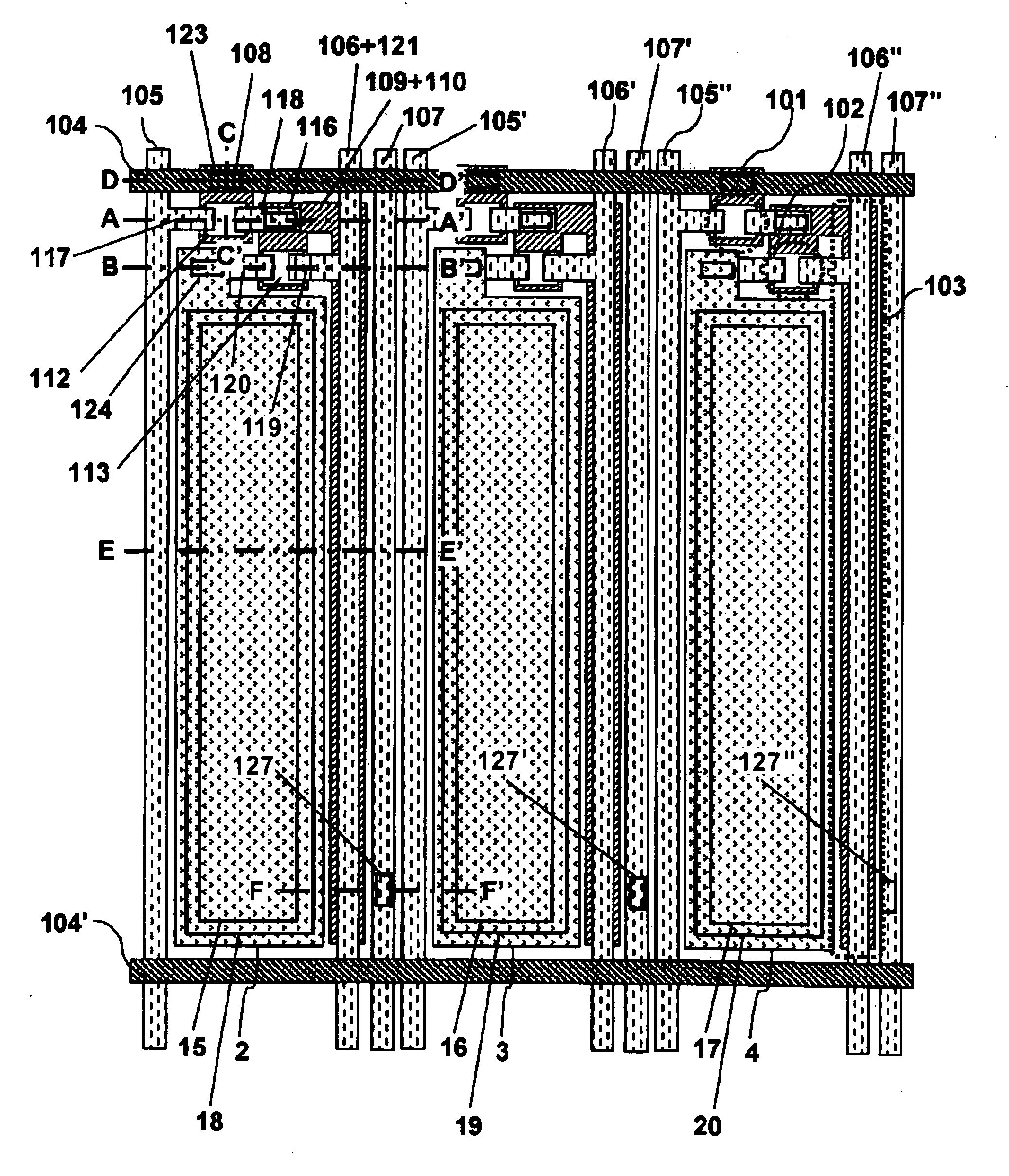Organic electro-luminescent display apparatus
- Summary
- Abstract
- Description
- Claims
- Application Information
AI Technical Summary
Benefits of technology
Problems solved by technology
Method used
Image
Examples
embodiment 1
[0097]FIG. 1 is a plane view of one color pixel of an organic electro-luminescent display apparatus according to a first embodiment of the present invention. Here, one color pixel was configured with three-primary-color subpixels of green, red, and blue. Also, FIG. 2A is a cross-sectional view of the apparatus along an A-A′ line in FIG. 1. FIG. 2B is a cross-sectional view of the apparatus along a B-B′ line in FIG. 1 similarly. FIG. 2C is a cross-sectional view of the apparatus along a C-C′ line in FIG. 1 similarly. FIG. 2D is a cross-sectional view of the apparatus along a D-D′ line in FIG. 1 similarly. FIG. 2E is a cross-sectional view of the apparatus along an E-E′ line in FIG. 1 similarly. FIG. 2F is a cross-sectional view of the apparatus along an F-F′ line in FIG. 1 similarly.
[0098]In FIG. 1 and FIG. 2A to FIG. 2F, on a glass substrate 21, a plurality of scanning lines 104 were arranged with a constant spacing placed therebetween. Simultaneously, a plurality of signal lines 10...
embodiment 2
[0133]FIG. 5 is a plane view of one color pixel of an organic electro-luminescent display apparatus according to a second embodiment of the present invention. FIG. 6A is a cross-sectional view of the apparatus along an A-A′ line. FIG. 6B is a cross-sectional view of the apparatus along a B-B′ line. FIG. 6C is a cross-sectional view of the apparatus along a C-C′ line. FIG. 6D is a cross-sectional view of the apparatus along a D-D′ line. FIG. 6E is a cross-sectional view of the apparatus along an E-E′ line. FIG. 6F is a cross-sectional view of the apparatus along an F-F′ line. The point which differs from the above-described first embodiment is as follows: The gate line 104 of the present invention disposed at the upper layer as compared with the semiconductor layers 112 and 113, and the auxiliary line 107 of the upper transparent electrode 12, i.e., the second current supply line 107, were configured with the same layer and the same component. Based on this feature, while ensuring th...
embodiment 3
[0134]FIG. 7A is a cross-sectional view of an organic electro-luminescent display apparatus according to a third embodiment along a C-C′ line illustrated in FIG. 5. FIG. 7B is a cross-sectional view of the apparatus along a D-D′ line. FIG. 7C is a cross-sectional view of the apparatus along an F-F′ line. (The plane view of one color pixel and the cross-sectional views along the A-A′ line, B-B line, C-C′ line, and E-E′ line become the same as FIG. 5 and FIG. 6A, FIG. 6B, FIG. 6C, and FIG. 6E, respectively, and thus are omitted.) The point which differs from the above-described first and second embodiments is as follows: The gate line 104 of the present invention disposed at the upper layer as compared with the semiconductor layers 112 and 113 was formed over the second interlayer insulation film 125 and under the bank insulation film 126, i.e., the third interlayer insulation film 126. Based on this feature, while ensuring the heat-resistant property of the gate electrodes 108 and 10...
PUM
 Login to View More
Login to View More Abstract
Description
Claims
Application Information
 Login to View More
Login to View More - R&D
- Intellectual Property
- Life Sciences
- Materials
- Tech Scout
- Unparalleled Data Quality
- Higher Quality Content
- 60% Fewer Hallucinations
Browse by: Latest US Patents, China's latest patents, Technical Efficacy Thesaurus, Application Domain, Technology Topic, Popular Technical Reports.
© 2025 PatSnap. All rights reserved.Legal|Privacy policy|Modern Slavery Act Transparency Statement|Sitemap|About US| Contact US: help@patsnap.com



